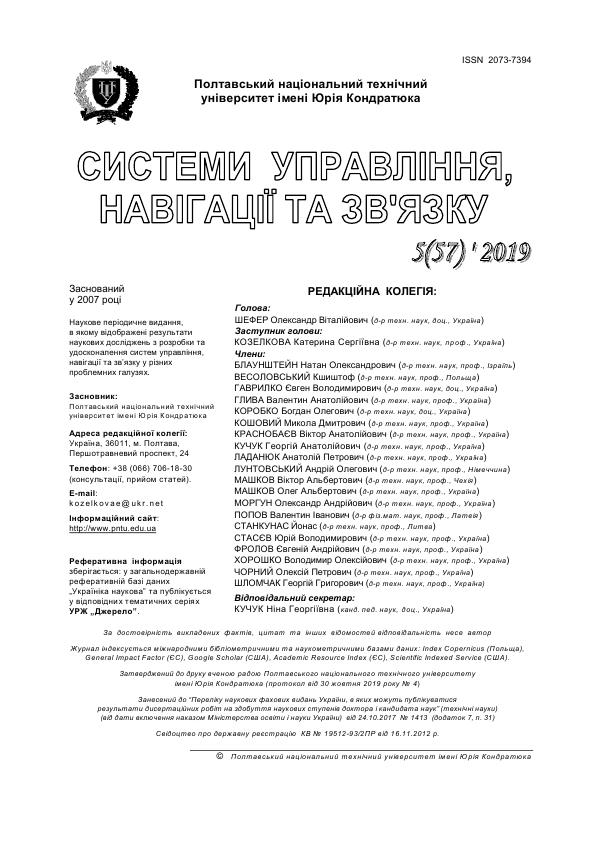ДОСЛІДЖЕННЯ ЗАХИСНИХ ВЛАСТИВОСТЕЙ МЕТАЛЕВИХ ЕЛЕКТРОМАГНІТНИХ ЕКРАНІВ ТА ВИЗНАЧЕННЯ УМОВ ЇХ МАКСИМАЛЬНОЇ ЕФЕКТИВНОСТІ
DOI:
https://doi.org/10.26906/SUNZ.2019.5.103Ключові слова:
електромагнітні поля, випромінювання, екранування, електромагнітна сумісність, технічні засобиАнотація
Захисні властивості сплавів у різних частотних діапазонах екрануючих матеріалів мають складний характер. Предмет дослідження даної роботи – визначення амплітудно-частотних залежностей коефіцієнта екранування електромагнітних полів сучасними металевими сплавами. Досліджено: традиційні матеріали; електротехнічні сталі різного класу та алюмінієвого сплаву, які мають різну ширину захисного екрану; металовмісні шнури різного (двошарового та тришарового) сплетіння. Досліджено залежності захисних екранувальних властивостей магнітного поля за рахунок відбиття для електротехнічної сталі класу 121 та сплаву з дюралюмінію та електротехнічної сталі. Мета роботи – визначення коефіцієнтів екранування у низькочастотній та середньо-частотній областях електромагнітного спектра на основі вимірювання коефіцієнтів екранування найбільш поширених металевих захисних матеріалів та надати обґрунтовані рекомендації щодо їх найбільш ефективного використання у робітничих умовах для захисту від електромагнітних полів та випромінювань працюючих та сумісності електричного та електронного технічного обладнання. Розроблено амплітудно-частотні залежності коефіцієнта екранування електромагнітних полів сучасними стандартними металевими сплавами для захисту людей і для забезпечення електромагнітної сумісності електричного та електронного технологічного обладнання. Запропоновано захисні заходи захисту від впливу від електромагнітних полів та випромінювань, що засновані на принципах розумної достатності, з урахуванням мінімальних витрат. Доведено експериментально та економічно обґрунтовано, що найбільш ефективним засобом захисту від електромагнітної безпеки на підприємствах в умовах складної дії різноманітних електромагнітних полів, є електротехнічні сталі. В результаті отриманих співвідношень захисних властивостей (за рахунок електромагнітної енергії та відбиття електромагнітних хвиль) раціоналізовано захисні модифікаційні конструкції з мінімальним коефіцієнтом відбиття електромагнітних хвиль у небажаному напрямку в різному частотному діапазоні. Такі висновки надали змогу запропонувати методологію розрахунку щодо необхідної оптимальної товщини захисного магнітного екрана найбільш сприятливої ефективності у даних умовах. Це дозволяє мінімізувати обсяг довідникових та експериментальних даних та однозначно визначити товщину екрана необхідної ефективності, а також зменшує загальну вартість захисної конструкції.Завантаження
Посилання
Державні санітарні норми і правила при роботі з джерелами електромагнітних полів: Д Сан Пін 3.3.6.096-2002. [Чинний від 2003-01-04]. К.: МОЗ України, 2003. 16 с. (Державні санітарні норми України).
Резинкина М. М., Гринченко В. С., Думанский Ю. Д., Медведев С. В. Экранирование магнитного поля промышленной частоты в рабочих зонах электростанций. Гігієна населених місць. 2010. Вип. 55. С. 249–255.
Резинкина М. М. Использование численных расчётов для выбора средств экранирования от действия магнитных полей. Журнал технической физики. 2007. Т.77., № 11. С. 17–24.
Bhattacharjee S. Protective Measuresto Minimizethe Electromagnetic Radiation. Electronicand Electric Engineering. 2014. Vol. 4. P. 375–380.
Панова О.В. Захист працюючих від впливу електромагнітних полів екрануванням: дис. … канд. техн. наук: 05.26.01 / Державна установа «Національний науково-дослідний інститут промислової безпеки та охорони праці». Київ, 2014. 151 с.
Пристрій контролю захисних властивостей електромагнітних екранів: пат. 58604 Україна: МПК G01L9/00; заяв. 15.03.2011; опубл. 11.04.2011, Бюл. № 7.
Мордачев В. И., Юрцев О. А., Литвинко П. А. Влияние декоративных металлических покрытий зданий на электромагнитную обстановку и электромагнитную совместимость радіосистем. Вестник белорусского государственного технического университета. 2009. № 6. С. 42–47.
Панова О.В. Загальні критерії застосування електромагнітних екранів для забезпечення електромагнітної безпеки та сумісності технічного обладнання. Вісті Донецького гірничого інституту. 2018. Вип. 2. URL: https://jdmi.donntu.edu.ua/wp-content/uploads/2019/02/Panova_JDMI_2_2018.pdf
Glyva V. A., Podoltsev A. D., Bolibrukh B. V., Radionov A. V. A thin electromagnetics field of a composite structure made on the basis of a magnetic fluid. Tekhnichna elektrodynamika. 2018. № 4. Р. 14–18.




